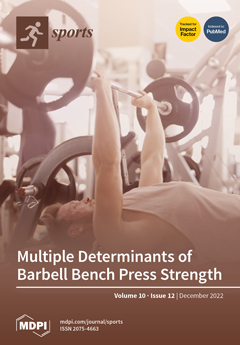The current study aimed to examine the effects of adding specific high-load resistance exercises to a high-intensity functional training (HIFT) program on healthy adults’ physical fitness and body composition. Twenty recreationally active volunteers (30 ± 4 y, 12 females, 8 males) were randomly
[...] Read more.
The current study aimed to examine the effects of adding specific high-load resistance exercises to a high-intensity functional training (HIFT) program on healthy adults’ physical fitness and body composition. Twenty recreationally active volunteers (30 ± 4 y, 12 females, 8 males) were randomly assigned to either a HIFT-control (HIFT-C,
n = 10) or HIFT-power (HIFT-P,
n = 10) group and trained three times per week for eight weeks. The HIFT-C protocol included four rounds of an 8-exercise circuit (30:15 s work: rest, 2 min rest after the second round). The exercises used were clean-and-press, box jump, TRX chest press, wall ball throws, burpees, repeated 10 m sprints, sumo squat-and-upright row, and abdominal crunches. The HIFT-P-group replaced TRX chest press with bench press and squat-and-upright row with squat, both at an intensity of 80% 1 RM. Before and after the intervention, participants underwent an evaluation of body composition, cardiorespiratory fitness, vertical jump, 1 RM bench press, and the maximum number of abdominal crunches in 1 min. In both groups, cardiorespiratory fitness, squat jump, countermovement jump, bench press 1 RM, and percent body fat improved significantly after the intervention (
p < 0.050), while a trend towards significant time x group interaction was found for bench press 1 RM (
p = 0.076), indicating a superiority of HIFT-P over HIFT-C. Muscle mass significantly increased by 3.3% in the HIFT-P group, while abdominal muscle endurance improved by 16.2% in the HIFT-C group (
p < 0.050). Short-term HIFT resulted in improvements in whole-body cardiorespiratory and neuromuscular fitness and reduction of body fat. The addition of high-load resistance exercises was well tolerated and resulted in increased muscle mass and upper body maximal strength. HIFT-P programs can be suitable for individuals seeking to enhance muscle mass and physical fitness in a short time.
Full article






